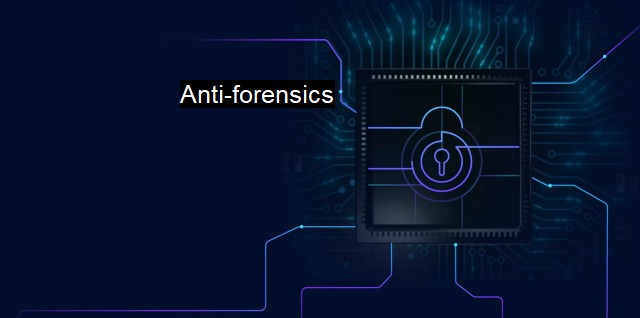What are Anti-forensics?
Understanding Anti-Forensics: Techniques Used by Attackers to Hinder Digital Investigations and Challenge Cybersecurity Measures
Anti-forensics is a practice commonly arising in the digital world, specifically within the scope of cybersecurity and antivirus protection. It denotes activities designed to hamper digital forensic investigations or potentially obscure the detection of various forms of malicious software. anti-forensics seeks to either obfuscate, modify, or completely erase digital evidence so that forensic examiners' efforts in data analysis and recovery are impaired. This act is typically performed by malicious hackers intending to evade detection, disrupt investigations, and maintain continuous control over their targeted system without raising alarms.Anti-forensic techniques can take many forms. One of these is the alteration of file formats, making it difficult for digital forensic tools to read the data. Cybercriminals can also use encryption and steganography to hide offensive data. Steganography, for instance, involves hiding data within innocent-looking files like images, effectively bypassing standard detection methods.
Artifacts-Wiping is another technique used by fraudsters. It includes the process of deleting certain kinds of data like log files which could have provided a trail pointing to their illicit activities. Cyber-criminals can also use certain tools that enable them to overwrite disk free space, making the retrieval of deleted files virtually impossible.
Cybercriminals employ anti-forensic practices through the manipulation of timestamps on files and directories, known as Time Stomping. This technique might render investigators unable to identify when a specific event occurred.
In the advanced interplay of antivirus software and cybersecurity, anti-forensic actions become broader and more sophisticated. To combat malicious codes from many modern-day malware creators, antivirus software processes massive amounts of data and uses Machine Learning (ML) algorithms to identify potential threats. advanced anti-forensic tactics can impede antivirus software's ideal functionality.
Skilled cybercriminals, understanding how malware detection systems work, can skillfully modify malware to prevent its detection, a method often known as obfuscation. They might use polymorphic code that changes itself every time it is executed, applying a unique encryption making the tracing even harder. Some can also utilize exploiting software vulnerabilities or zero-day threats to gain illicit access to systems before antivirus software vendors even have the chance to address these weaknesses.
It's worth mentioning that not all anti-forensic activity originates from the hostile intentions. Legitimate users and organizations often engage in anti-forensic procedures as a method to ensure privacy and secure data deletion. For instance, companies may wipe disks entirely before physically disposing of them to prevent any potential recovery of sensitive information.
Anti-forensics presents an evolved level of complexity in the world of cybersecurity and antivirus technology. Detection and prevention of such tactics require constant upgrades and staying updated with the ever-progressing technological challenges. To this end, cybersecurity companies drive continuous efforts, investing in advanced tools programmed with intelligence to detect and counter these sophisticated anti-forensic attacks. Therefore, keeping systems safe from these threats necessitates advanced security strategies to anticipate and confront these sophisticated techniques. Developing decryption algorithms, monitoring network behavior efficiently, and enforcing stricter control over file permissions, for instance, could all serve as effective shields against anti-forensic attacks. Regardless of the evolved tactics anti-forensics deploy, through ongoing vigilance and strategy evolution, security can remain one step ahead.

Anti-forensics FAQs
What is anti-forensics in cybersecurity?
Anti-forensics refers to a set of techniques and tools used by attackers to subvert or thwart digital forensics investigations. It involves hiding or altering the evidence of a cyber attack in order to avoid detection and prosecution.What are some common anti-forensic techniques used by attackers?
Some common anti-forensic techniques used by attackers include disk wiping, file obfuscation, file deletion, encryption, steganography, rootkits, and malware that targets forensic tools.How do cybersecurity professionals detect and respond to anti-forensics techniques?
Cybersecurity professionals can detect and respond to anti-forensics techniques by using advanced forensic tools and techniques that are specifically designed to uncover hidden or altered data. They can also use threat intelligence and behavioral analysis to identify suspicious activity and track down the source of the attack.Why is it important to have anti-forensic measures in antivirus software?
It is important to have anti-forensic measures in antivirus software because attackers often use anti-forensics techniques to evade detection and avoid being caught. By incorporating anti-forensic measures into antivirus software, cybersecurity professionals can better protect against these types of attacks and minimize the damage caused by cyber criminals.Related Topics
Digital Forensics Stealth Techniques Malware detection Intrusion Detection Memory forensics
| | A | | | B | | | C | | | D | | | E | | | F | | | G | | | H | | | I | | | J | | | K | | | L | | | M | |
| | N | | | O | | | P | | | Q | | | R | | | S | | | T | | | U | | | V | | | W | | | X | | | Y | | | Z | |
| | 1 | | | 2 | | | 3 | | | 4 | | | 7 | | | 8 | | |||||||